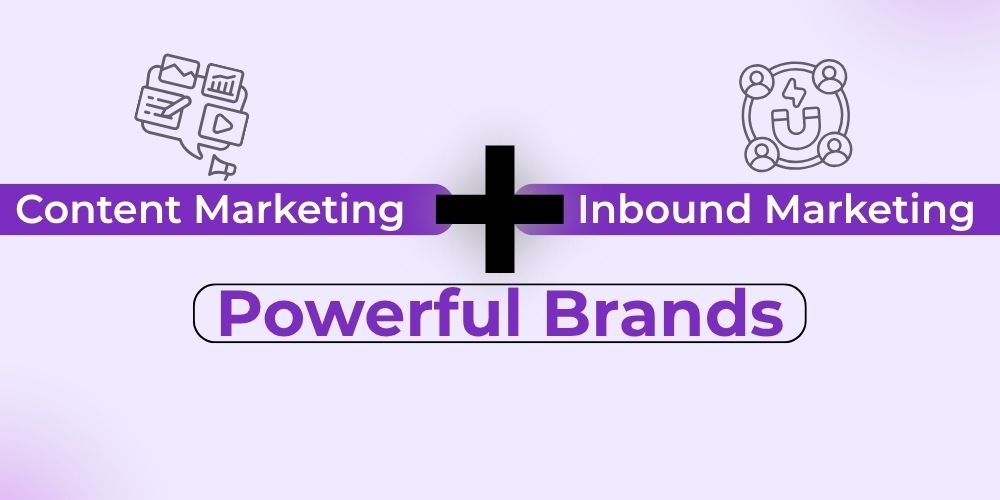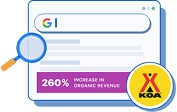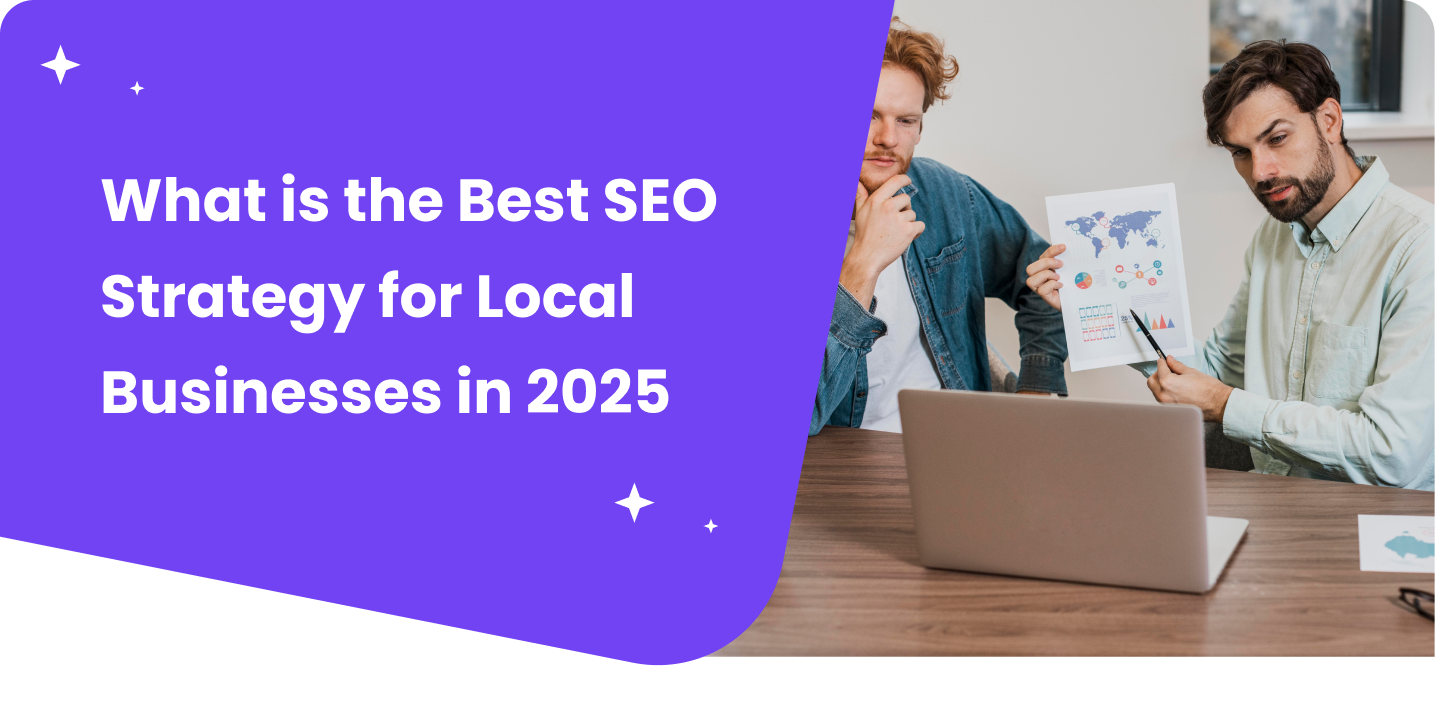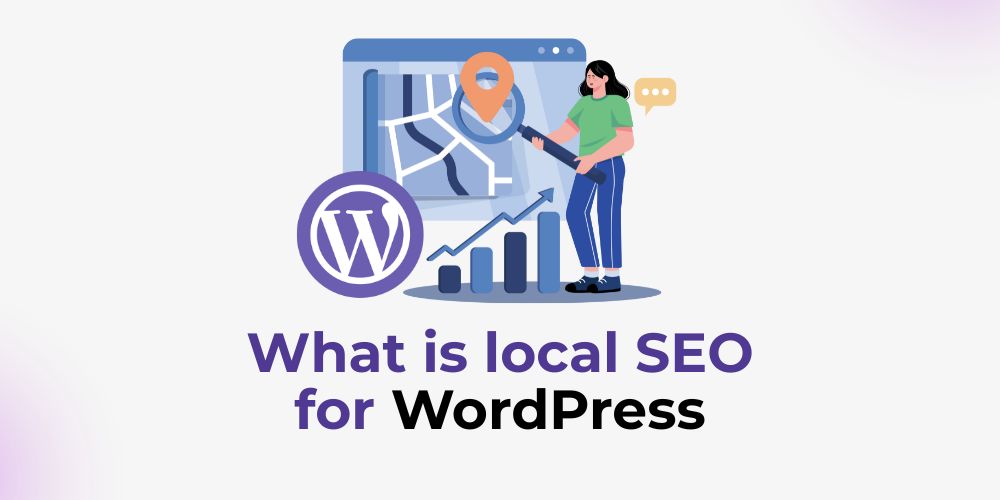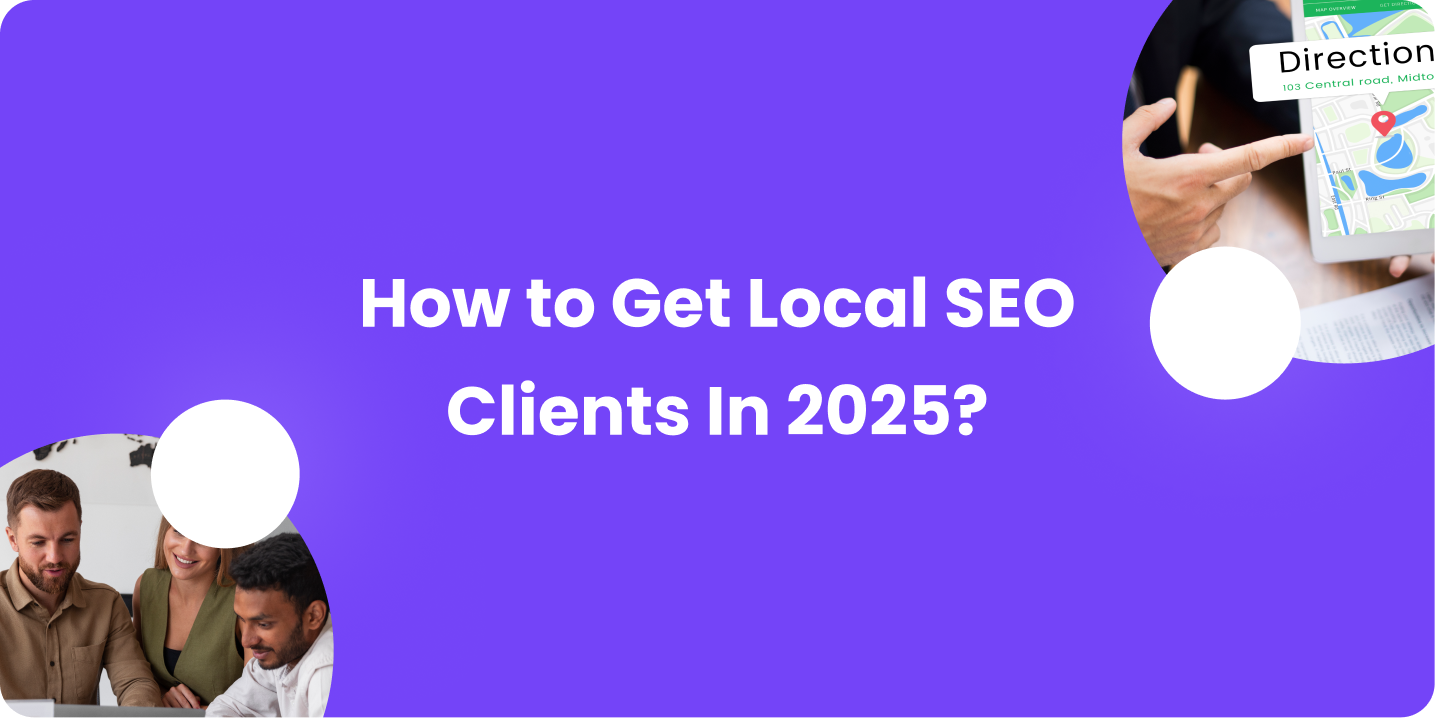If your content isn’t helping someone, it’s just noise. That’s the hard truth about content marketing, the engine that drives meaningful engagement in today’s digital world.
When done right, it’s not just a strategy; it’s a relationship builder, a trust enhancer, and often, the reason someone chooses you over the competition.
What Is Content Marketing, Really? At its heart, content marketing is all about delivering meaningful and relevant information that draws the right people in, keeps them interested, and ultimately turns them into loyal customers.
But make no mistake, it’s not about constantly promoting your products or services. That approach turns people off more than it pulls them in.
It’s about listening deeply and offering insights so genuinely helpful that people start to see you as the obvious solution.
At The Meta Future, we believe the best content marketing starts with empathy and ends in action. We’re not in the game to just rank higher on search engines, we’re here to solve real problems.
That means crafting content that educates, empowers, and makes people say, “This is exactly what I needed.”
In a world overloaded with information, helpfulness is your biggest differentiator.
How Content Marketing Sell Stories?
Let’s start with content marketing, the engine that makes people lean in and listen. Content marketing involves producing and distributing valuable content that draws in your target audience, keeps them interested, and ultimately drives them to take action.
But here’s the thing, it only works when the content actually helps people. This isn’t about promoting your services on loop. It’s about being so helpful that people naturally want to work with you.
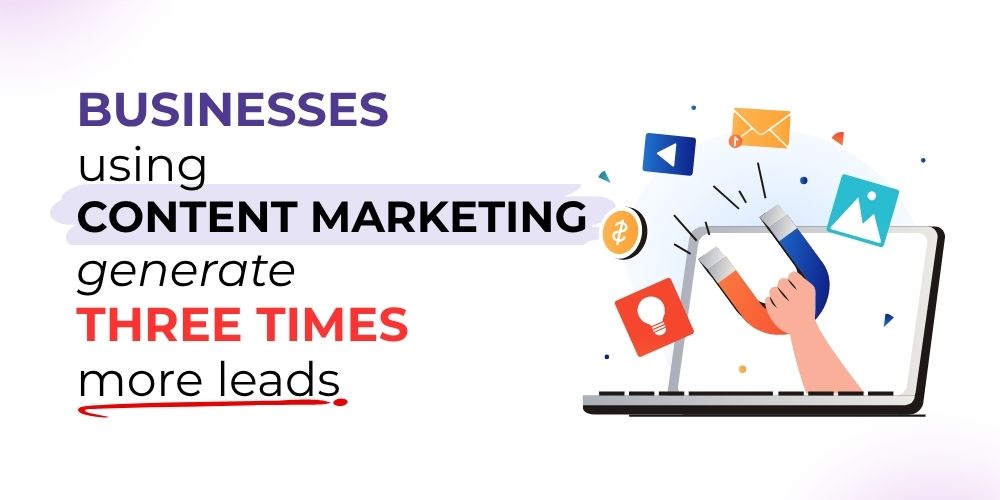
We’ve seen content marketing work best when it’s rooted in empathy and education. We’re not just publishing blog posts for the sake of SEO, we’re solving real problems.
Examples of Content Marketing
We’ve helped a sustainable food startup build traction by developing a blog series about conscious eating, featuring expert interviews and easy, actionable tips.
Their blog traffic tripled in two months, not because we shouted louder, but because we spoke with purpose.
Here’s what strong content marketing might include:
- Blog articles that educate and answer common customer questions
- Ebooks and whitepapers that dive deep into a topic your audience cares about
- Email newsletters that share updates and resources
- Conversation-starting and traffic-generating social media content
- Videos that explain your products or bring your brand story to life
- Infographics that break down complex data in a visually appealing way
What Makes Content Marketing Powerful?
- It builds trust before the sales pitch ever happens
- It improves SEO, making your site easier to find
- By bringing in the right people, it creates qualified leads.
- It turns your brand into a go-to resource, not just a seller
And the best part is, unlike ads, good content keeps working long after you hit publish.
How Inbound Marketing Attract, Engage, Delight
When we think of traditional marketing, it often feels like being interrupted, ads that pop up when we’re watching something, calls from numbers we don’t know, emails we didn’t ask for.
That’s the old way.
Inbound marketing flips the script. It’s about creating experiences that pull people toward your brand, not push your message on them. At its heart, inbound marketing is rooted in the idea that if you help people first, business will follow.
Inbound marketing is a strategy that uses content, SEO, social media, email, and marketing automation to:
- Attract strangers and turn them into visitors
- Engage the visitors that come on your website and convert them into leads or customers
- Delight those customers so they stay, refer, and grow with you
It’s a cycle, not a one-time transaction. You’re building relationships, not just funnels.
The Core Stages of the Inbound Methodology
Let’s break it down into its three main stages, something we apply in almost every client project at The Meta Future:
1. Attract
Here, your goal is to bring the right people to your website or content hub using:
- Blog content with smart SEO
- Educational videos
- Social media campaigns
- Strategic landing pages
We worked with an EdTech platform offering online executive coaching. Their biggest challenge? Low visibility.
We built a knowledge base filled with articles like “How to Choose the Right Executive Coach,” and optimized it for long-tail search queries.
The result were as expected. We got a 4x increase in organic traffic in just three months, without spending even a penny on ads.
2. Engage
Now that they’re here, you need to connect with them. This is where things like lead magnets, gated content, email sequences, and interactive tools (like assessments or quizzes) come into play.
For a client in sustainable fashion, we created a “Style Your Ethics” quiz that helped users find their sustainable fashion personality.
Not only did it boost email sign-ups, it also helped segment leads by interest for more relevant follow-ups.
3. Delight
The journey doesn’t end after a sale. If anything, it begins there. You want your customers to feel so supported, informed, and inspired that they naturally become advocates.
We use things like:
- Personalized onboarding content
- Follow-up newsletters with extra value
- Customer success stories
- Community-building webinars
After helping a fitness coach launch an online program, we created a post-purchase content series of tips, mini workouts, and mindset videos.
Her client retention jumped by 30%, all through consistent, helpful content.
Inbound Marketing Examples
- HubSpot revolutionized how companies think about nurturing leads through its inbound-first approach.
- Airbnb focuses on content that tells host stories and traveler tips, creating an emotional connection.
- The Meta Future, We’ve helped ecommerce clients generate more leads by turning product descriptions into powerful storytelling assets that engage buyers at every stage of the funnel.
Where Content Meets Inbound Marketing?
You know that point when everything starts to connect and feels right? That’s exactly what happens when content and inbound marketing meet. They’re different, sure, but when paired together, they become unstoppable.
Let’s be clear: content is the fuel. Inbound is the engine. One without the other? You’re either sitting still or running on empty.
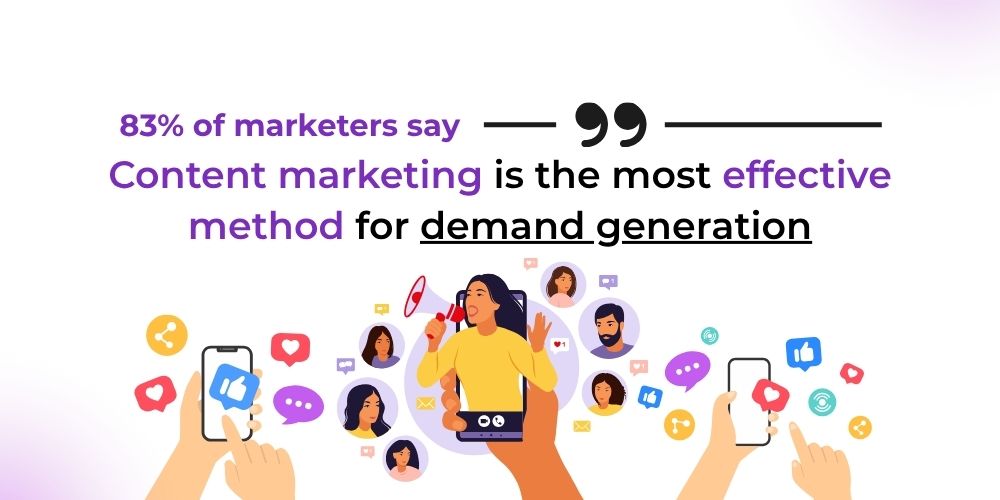
But the real question is, why inbound marketing can’t thrive without content? Inbound marketing isn’t just a strategy, it’s a system that relies completely on content.
From the moment a visitor lands on your site to the day they become a loyal customer, it’s the words, videos, images, and experiences you create that keep them engaged.
When we worked with a life coaching platform at The Meta Future, the biggest problem wasn’t tech, it was trust.
People weren’t signing up because they didn’t feel seen. We flipped the script by producing a series of blog posts and short reels that addressed real-life emotional blocks, mindset myths, and coaching success stories. That content became the emotional glue that held the entire inbound strategy together.
Here’s how we think about it: Content Is the Voice of Inbound
Let’s break down the core inbound stages and show how content fits into each one:
- Attract = Blog Posts, SEO Pages, Social Content
We attract by giving away value for free. No catch. No hard sell. Just helpful, well-optimized content that answers real questions.
- Engage = Ebooks, Webinars, Quizzes, Email Series
We engage by diving deeper, offering content that solves a specific pain point in exchange for a connection (email, signup, response).
- Delight = How-To Videos, Client Support Articles, Community Features
We delight by showing up even after the purchase, through personalized, useful content that builds loyalty and advocacy.
Curious why content makes inbound work? let’s look at the magic content brings into the inbound marketing framework:
- It’s educational. People trust brands that teach rather than preach.
- It builds relationships. The right story, told at the right time, forms emotional bonds.
- It’s scalable. One great guide can generate leads for years.
- It answers search intent. That means higher rankings and qualified traffic.
- It humanizes your brand. Good content shows you understand, not just sell.
When we partnered with a wellness brand struggling to convert interest into action, the fix wasn’t more ads, it was better content.
We built an inbound journey around one killer blog series on “Daily Rituals for Busy Women.” From there, we created a lead magnet workbook, sent follow-up emails with mini habit challenges, and featured success stories on Instagram.
So, what was the result? Not just clicks, but real conversions. People stayed, signed up, and shared.
Content Marketing vs. Inbound Marketing
Here’s where many brands get tripped up: they use the terms content marketing and inbound marketing like they’re the same thing. They’re not. But they’re close, like siblings with different roles in the same family business.
It’s easy to confuse them because they work so tightly together. But knowing the difference is what makes your strategy smarter, sharper, and more results-driven.
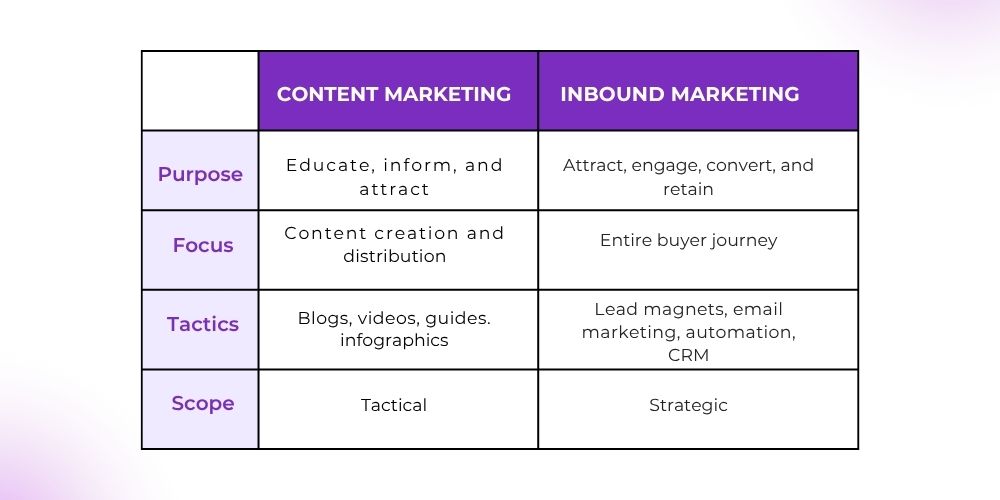
So… What’s the Difference?
Let’s put it simply:
- Content marketing is the creation and distribution of valuable content to attract an audience.
- Inbound marketing is a broader methodology that uses content (along with other tools) to attract, engage, and delight.
Think of It Like This:
If content marketing is writing a helpful guide for your customers, inbound marketing is delivering that guide at the right time, to the right person, via the right channel, and using it to build a long-term relationship.
But the funny part is when you think you’re doing one but you’re doing the other. it is actually a real-life confusion.
We’ve seen it happen plenty of times. A business publishes a blog every week and wonders why nothing changes. The content is there, but there’s no inbound structure to convert readers into leads. No SEO, no lead magnet, no email funnel. That’s content without inbound.
On the flip side, we’ve also seen companies run email sequences and social ads but forget to update their website or publish content regularly.
They’re trying to run inbound without giving their audience anything new to engage with. That’s inbound without content.
At The Meta Future, we’ve helped brands spot and fix this gap. One example was a Dubai-based ecommerce store that had a decent inbound setup, email flows, CRM, pop-ups.
But the content? Outdated, thin, and generic.
We stepped in with a fresh content strategy, weekly SEO blogs, product storytelling, user-generated campaigns, and suddenly, the same inbound flow started converting at 3x the rate.
How Content Powers of Inbound Marketing
When you look closely at how people actually make decisions online, you’ll notice something: they don’t just wake up and buy. They go through a journey. They Google things. Read stuff. Ask questions. Get advice. Sleep on it. And then… maybe… they buy.
That’s where the real magic of content in inbound marketing comes in. Each stage of the buyer’s journey needs its own kind of content. Miss one, and your entire funnel could spring a leak.
We’ve mapped out this journey for dozens of brands, fitness platforms, fashion startups, learning academies, and there’s a clear pattern. Let’s walk through it.
- Awareness Stage: “I Have a Problem, But I’m Not Sure What I Need”
This is where it all begins. People are just realizing they have a need, a goal, or a pain point. Your job here? Be helpful, not salesy.
What kind of content works here:
- Educational blog posts (like this one)
- Social media posts addressing common challenges
- Introductory videos and explainers
- SEO content focused on questions (“What is X?” or “How to solve Y?”)
We helped a sustainable fashion label publish a blog series called “The True Cost of Fast Fashion.” It didn’t promote their products directly, but it educated. And that education earned attention, backlinks, and shares. It sparked interest in their mission, which led to newsletter signups and purchases down the line.
- Consideration Stage: “I Know What I Want. I’m Exploring My Options.”
At this point, your audience is comparing solutions. They know what their challenge is, and now they’re figuring out how best to solve it. Your job here? Build trust and authority.
What kind of content works here:
- Case studies
- Comparison guides (your service vs competitors)
- Webinars
- In-depth blog content or whitepapers
- Expert interviews
We built a “Coaching Platform Showdown” blog for a life coaching client. It broke down the top 5 platforms, with honest pros and cons, including our client’s platform. Transparency paid off. That single blog became one of their top lead-generating pieces.
- Decision Stage: “I’m Ready to Buy. Convince Me You’re the Right Choice.”
Now your audience is warmed up. They know their options. They’re looking for that final push of confidence. This is where content should show proof, spark urgency, and make the decision easy.
What kind of content works here:
- Testimonials
- Product demo videos
- Pricing pages
- Free trials
- Customer success stories
- Personalized email flows
For a client in the wellness space, we created a video testimonial series of real users sharing how their lives changed after the program. Each video was short, authentic, and emotion-driven. When we added those to landing pages and retargeting ads? Conversion rates jumped by 40%.
Why This Works So Well
- It respects the buyer’s journey. You’re not rushing people. You’re guiding them.
- It personalizes the experience. You meet them where they are.
- It builds lasting trust. At each step, your content is showing value, not just shouting benefits.
And as we’ve seen over and over again at The Meta Future, when brands take the time to map content to each stage of inbound, they don’t just increase traffic. They increase trust, time on site, conversion rates, and customer retention.
Key Steps of Winning Content Marketing Strategy
Alright, we’ve unpacked the theory, explored the stages, and seen how content and inbound are deeply connected. But how do you actually build a strategy that uses both, intentionally?
This is where most brands freeze. They’re either:
- Creating great content but not aligning it with the buyer’s journey
- Running inbound campaigns without fresh, relevant content to fuel them
We’ve seen this play out time and again. But when the pieces align? That’s when brands scale.
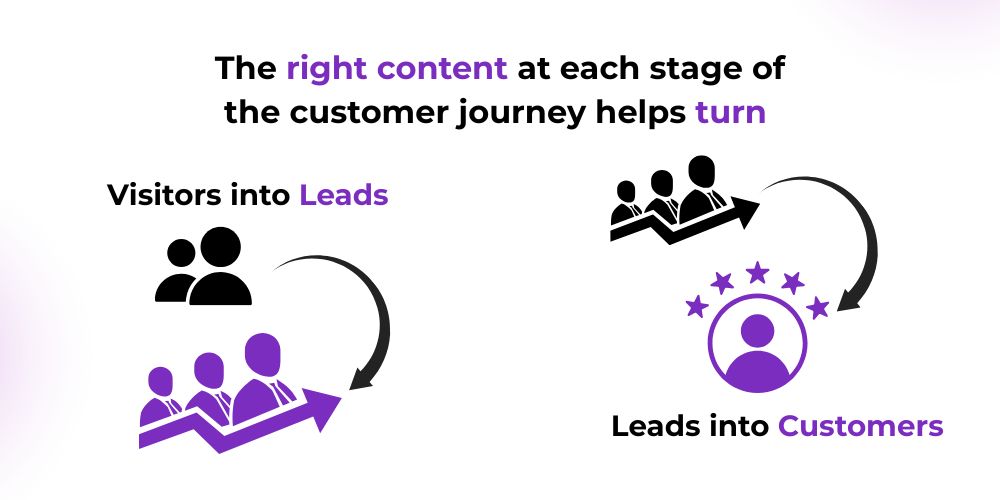
We build content-driven inbound strategies by following a step-by-step approach. It’s simple, but powerful when done right.
Step 1: Start With the Customer Journey
This is the foundation. We map out:
- What your ideal customer is thinking, feeling, and searching for at each stage
- What obstacles they face
- What type of content they’d find helpful right now
For an executive education platform, we started by identifying key questions their users were Googling. Then, we built an awareness-stage blog hub addressing leadership burnout, upskilling paths, and career plateaus. From there, we guided visitors into consideration-stage assets like course comparisons and testimonials.
Step 2: Create Content That Aligns With Each Stage
We make sure each piece of content serves a purpose, not just fills space. Every article, video, or case study is mapped to a specific phase in the inbound journey.
Use this framework:
- Awareness = Blog posts, SEO pages, tip-based social content
- Consideration = Case studies, downloadable guides, webinar invites
- Decision = Testimonials, comparison checklists, offer-driven CTAs
Step 3: Use Smart Distribution (Don’t Just Post and Pray)
Once the content is live, we don’t leave it hanging. We amplify it using:
- SEO optimization with primary and secondary keywords
- Email sequences tailored to where leads dropped off
- Social posts and stories that tease content highlights
- Retargeting campaigns to nudge interest back into actio
We took a single guide on “How to Choose the Right CMS” and:
- Turned it into 5 LinkedIn posts
- Featured it in a lead-nurturing email sequence
- Created a short video version for Instagram Reels
- Used it as gated content for lead gen ads
That one piece drove conversions for months.
Step 4: Track, Tweak, and Iterate
No strategy is set in stone. What makes inbound + content powerful is that it’s measurable. We regularly track:
- Time on page
- Bounce rate
- Scroll depth
- Click-throughs
- Conversion rates
Then, we adjust. Titles get refined. CTAs get repositioned. New content fills gaps.
Tools we use:
- Google Analytics for traffic and behavior
- HubSpot for lead tracking
- SEMrush for keyword and topic performance
- Hotjar for on-site user engagement
Step 5: Keep It Human
This is the part that gets lost in the data. But it’s the most important.
We’re not just creating content for the algorithm, we’re speaking to real people. That’s why we write with empathy, use storytelling, and share real experiences.
We believe in human-first content. It’s the kind that builds relationships, not just rankings.
Want the formula? Here it is:
Strategic inbound marketing + Purposeful content = Scalable, trust-driven growth
It’s not about reinventing the wheel. It’s about aligning every piece of your marketing puzzle, and doing it with clarity and intent.
Success Stories of Brands That Nailed Content-Driven Inbound
We’ve talked strategy. We’ve shared the playbook. But let’s be real: nothing drives the point home like seeing it in action.
These aren’t theories. They’re stories of brands, big and small, that used content + inbound to transform their growth. And honestly? Many of the principles they used are the same ones we apply every day at The Meta Future.
Here’s how it looks when it works:
HubSpot – Turning Education Into Empowerment
HubSpot isn’t just a marketing platform, it’s a content powerhouse. They’ve built a universe of blogs, templates, certifications, and free tools that support every step of the inbound journey.
What they did right:
- Their blog answers literally everything a marketer, salesperson, or entrepreneur might Google.
- Their gated templates (like email swipes and editorial calendars) turn traffic into leads effortlessly.
- Their free CRM removes the barrier for entry and supports long-term nurturing.
What we learned: When you offer real value up front, trust becomes your most powerful conversion tool. It’s not about selling, it’s about helping until people want to buy.
Airbnb – Storytelling That Scales
Airbnb doesn’t just list rentals, they tell stories. They’ve mastered the art of humanizing their brand through host stories, travel tips, and user-generated content.
How they nailed inbound content:
- Their “Stories from the Airbnb Community” blog builds connection and loyalty.
- Their social content highlights real people, not features or prices.
- They use email content to guide users based on browsing habits and destinations.
What we learned: Inbound isn’t always formal. When your content reflects real people with real lives, it doesn’t just convert, it resonates.
Shopify – The Underdog Platform That Became a Content Giant
Shopify started with a mission to help small businesses sell online. Today? Their content engine drives millions of entrepreneurs to their platform.
Here’s their secret sauce:
- Tutorials, how-tos, and success stories fuel their blog.
- Inbound flows lead from guides to tools to product demos.
- Their YouTube channel is packed with free business-building lessons.
What we learned: You don’t need a huge budget to dominate inbound. You need consistency, clarity, and a deep understanding of your audience’s journey.
The Meta Future
Of course, we’ve seen it work up close too. Here are just a few snapshots from our own inbound + content projects:
- Ecommerce Startup
We developed a blog + email journey to guide users from discovery to first purchase. Within three months, organic traffic increased by 275% and abandoned cart recovery jumped by 35%.
- Online Coaching Brand
We built an inbound funnel starting with long-form blog content, leading to a “Coaching Clarity Quiz,” then an email course. Result? A 5x increase in discovery calls booked.
- Sustainable Food Platform
Our team created a series of SEO-optimized blogs tied to local sourcing and ethical eating. Combined with inbound lead nurturing, it helped the brand secure partnerships and media features organically.
Conclusion
If there’s one thing we know for sure, it’s this: marketing has changed, and there’s no going back. People don’t want to be chased. They want to be seen. Heard. Understood.
That’s exactly where content and inbound marketing come together, not just as buzzwords, but as a blueprint for smarter, more human business growth.
We’ve seen firsthand how blogs can spark trust, how guides can turn browsers into buyers, and how email flows can feel like thoughtful conversations, not sales traps. We’ve seen what happens when brands stop shouting and start helping.
And if you remember nothing else from this blog, content gives your brand a voice. Inbound gives that voice a direction.
Together, they don’t just generate leads, they build relationships that last. The brands that win the future won’t be the ones with the loudest ads.
They’ll be the ones with the clearest value, the best stories, and the most intentional strategies.
So if you’re ready to build a brand people want to buy from, not just once, but again and again, then it’s time to stop choosing between content and inbound.
It’s time to use both. Together. Strategically. And with heart.

